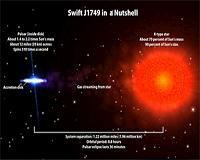 |
Paris (AFP) Aug 22, 2010 The Solar System could be nearly two million years older than thought, according to a study published on Sunday by the journal Nature Geoscience. The evidence comes from a 1.49-kilo (3.2-pound) meteorite, found in the Moroccan desert in 2004, that contains a "relict" mineral, which is one of the oldest solid materials formed after the birth of the Sun. Analysis of lead isotopes suggest the mineral was formed 4.45682 billion years ago, making the meteorite the oldest object ever found. As a result, the Solar System is likely to be between 300,000 and 1.9 million years older than previous estimates, says the paper, authored by Audrey Bouvier and Meenakshi Wadhwa of Arizona State University's the Center for Meteorite Studies.
Share This Article With Planet Earth
Related Links Stellar Chemistry, The Universe And All Within It
 Eclipsing Pulsar Promises Clues To Crushed Matter
Eclipsing Pulsar Promises Clues To Crushed MatterGreenbelt MD (SPX) Aug 19, 2010 Astronomers using NASA's Rossi X-ray Timing Explorer (RXTE) have found the first fast X-ray pulsar to be eclipsed by its companion star. Further studies of this unique stellar system will shed light on some of the most compressed matter in the universe and test a key prediction of Einstein's relativity theory. The pulsar is a rapidly spinning neutron star - the crushed core of a massive st ... read more |
|
| The content herein, unless otherwise known to be public domain, are Copyright 1995-2010 - SpaceDaily. AFP and UPI Wire Stories are copyright Agence France-Presse and United Press International. ESA Portal Reports are copyright European Space Agency. All NASA sourced material is public domain. Additional copyrights may apply in whole or part to other bona fide parties. Advertising does not imply endorsement,agreement or approval of any opinions, statements or information provided by SpaceDaily on any Web page published or hosted by SpaceDaily. Privacy Statement |